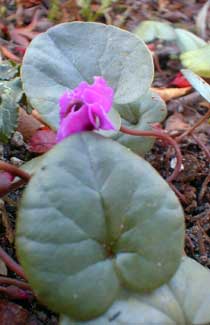
Magenta
Plain-leafed Winter Cyclamen
"Where pennyroyal & wild mint used to grow
And the earth sprouted Her first cyclamen,
There peasants bargained over cements
And the birds fell dead into the smelting furnace."
-Manos Hadjidakis
(1925-1994)
(1925-1994)
There are so many wonderfully pewtered, silvered, zoned, patterned, ornate, mottled, & variegated cyclamens, that it is nice to have a few completely plain cyclamens with purely sea-green unmarked leaves for extreme contrasts.
The leaves are almost perfectly round on the specimen shown, but on some there are varying degrees of slight to considerable leaning toward kidney shape. The first few leaves appear in October, more numerous in November, more numerous still in December.
Its first bright magenta blossoms appear as early as November, when the photo above was taken, but will be more numerous late December & January. The blooms are dumpy with dark chocolate-purple nose.
The full taxonomic name is Cyclamen coum ssp coum forma coum. The species is native to Bulgaria, Turkey, Syria, Lebanon & Israel, & found on all sides of the Black Sea, including Georgia, Crimea, & the far north of Iran.
Some gardeners report C. coum to be even more vigorous than C. hederifolium, but I'd regard it as equally hardy despite being less vigorous. The leaves' size & height are on average half that of C. hederifolium, so that C. coum can be overwhelmed & hidden by its autumn cousin if they interplanted too closely together.
Even so, I find ways to combine them, so that after the autumn flowering of C. hederifolium has faded away, the winter flowering of C. coum has begun in the same general vicinity, & their leaves close enough in proximity to invite comparisons right into early spring.
They are extremely cold-hardy despite that the tuber needs to be planted very near the surface. it will thrive down to Zone 6 easily & there are chances of success with them down to Zone 4. In cold areas or in places where winters are generally overcast they will do very well out in the open, but in warmer areas with brighter sunlight, partial shade is prefered.
Winter cyclamens need perfect drainage or dryness during their summer dormancy & moderate moisture during autumn & winter. If too wet they can rot out of the garden, but are surprisingly tough so that even in the rainy Northwest losses are unlikely. They like partial to considerable shade on well-draining stone ledges, or near the trunks of large shrubs or trees where little beyond cyclamens would be apt to thrive.
In their native habitats they frequently grow under large evergreens thus prefer acidic soil, which can be enriched with fallen pine or fir needles. In the garden they like it just as much under deciduous trees, but more care has to be taken to clear fallen leaves off of them.
I go out almost daily during leaf-fall to keep leaves off several species of cyclamens that are otherwise low maintenance. They won't necessarily be smothered in any damaging sense by fallen leaves, but they won't be as visible, & instead of forming compact bundles of leaves, they'll grow in a stringier spread-out manner trying to get some light.
Continue to
Cyclamen coum 'BSBE 518' Pewter